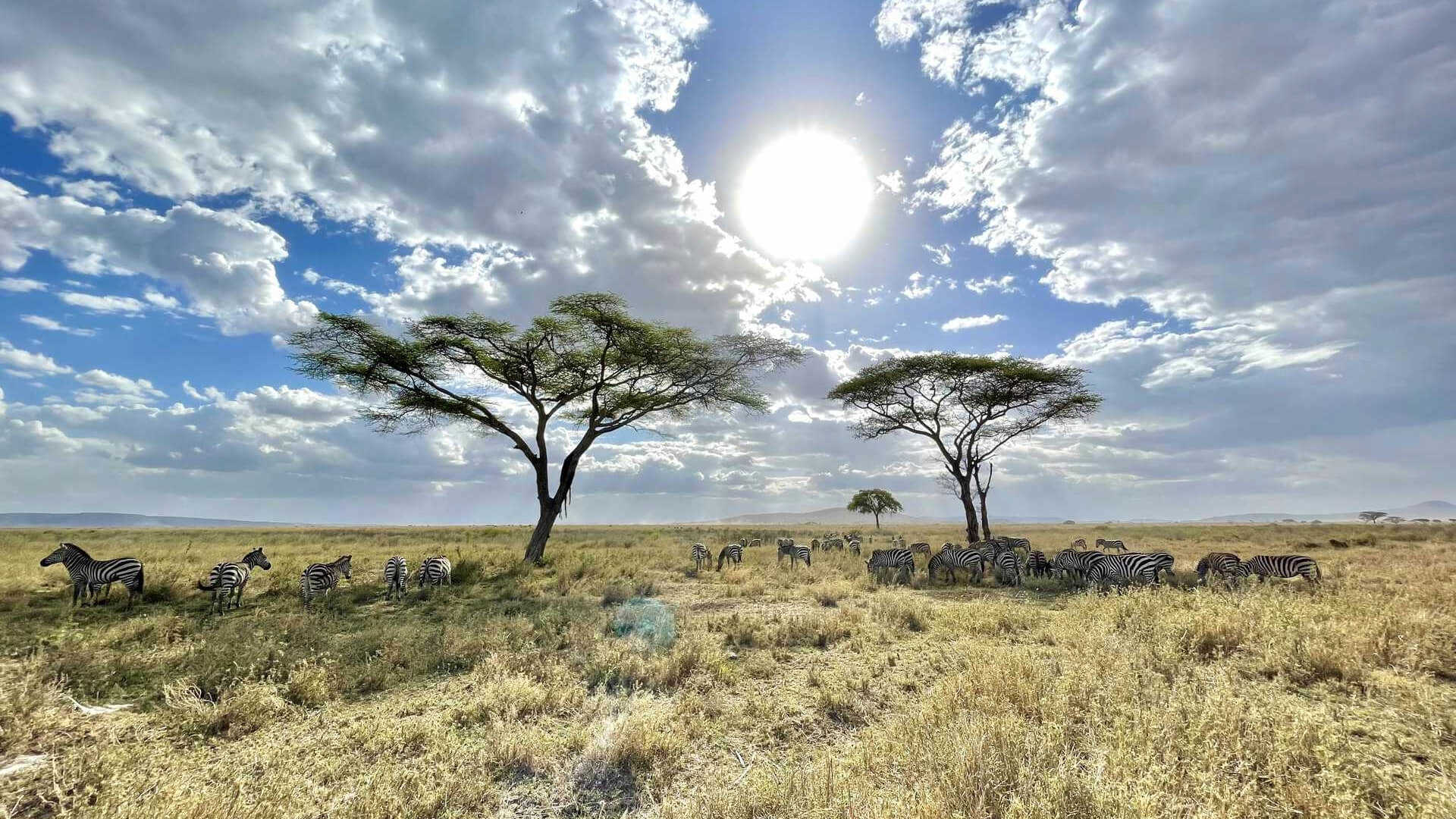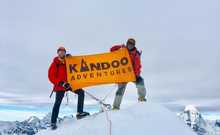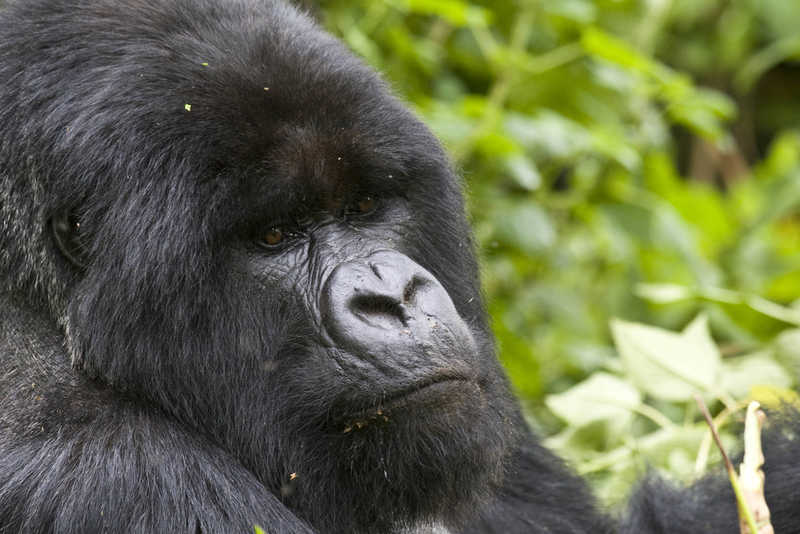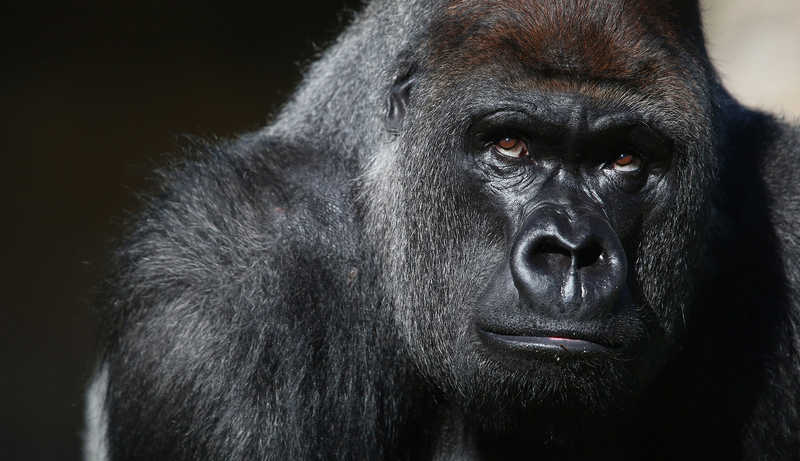Machame climb and safari
- Kandoo Summits

Contact
our UK team

All trekkers need to organise their own flights to Kilimanjaro International Airport (JRO). From JRO we will arrange a private transfer to your hotel. That night or early the next morning you will meet your local Kandoo representative and have a full pre-climb briefing.
Transfer from your hotel to Machame Gate for registration. Our porters prepare and pack our supplies and luggage before we start our ascent along the forest trail to Machame Camp at 3000m. We will stay here overnight.
After breakfast we start walking, leaving the rainforest behind, and continue our ascent, crossing a small valley and up to a steep rocky ridge, covered with heather. Our route now turns west into a river gorge until we reach Shira Cave Camp. It will be colder tonight than the previous night with temperatures possibly falling below freezing.
Today we will climb up to 4600m to the base of the Lava Tower for lunch and acclimatisation. This will be our toughest day so far and you may, for the first time, feel the altitude. After lunch we will descend again by almost 650m to Barranco Camp, following the ‘walk high, sleep low’ golden rue of acclimatisation. Our descent to Barranco Camp takes about 2 hours and offers great opportunities to take some beautiful photographs of the Western Breach and Breach Wall. The camp is situated in a valley below the Breach and Great Barranco Wall.
A short, but fun, day starting with a scramble to the top of the Great Barranco Wall. We then traverse over scree to the Karanga Valley (3930m) beneath the icefalls of the Heim, Kersten and Decken Glaciers. We will stay overnight at Karanga campsite.
We leave Karanga campsite behind to meet the junction connecting with the Mweka descent trail. From here we continue up to Barafu Camp. Here we can rest, enjoy dinner, and prepare for the summit day. The camp offers amazing views of the summit and the two peaks of Mawenzi and Kibo.
You will be woken around 23:30 with tea and biscuits. We start our trek to the summit between the Rebman and Ratzel glaciers through heavy scree up to Stella Point on the crater rim. This is the most mentally and physically challenging part of the trek. At Stella Point (5732m), we will stop for a short rest and hopefully be in time to witness the magnificent sunrise (weather permitting). We are now only an hour away from the summit, Uhuru Peak (5895m), the highest point on Mount Kilimanjaro and the continent of Africa. From the summit, we descend down to Mweka camp site, via Barafu Camp for lunch. Trekking poles will be needed for the loose scree going down to Mweka Camp (3100m). Later in the evening, we will enjoy our last dinner on the mountain and a well-earned sleep.
Your final day on the trek, departing after breakfast we descend a further 1300m to the Mweka Park Gate to pick up your summit certificates from the Park Headquarters. Transfer to your hotel.
Our safari guide and vehicle will collect you from your hotel and we will drive to Lake Manyara, arriving with plenty of time for an afternoon game-drive. Located beneath the cliffs of the Manyara Escarpment, on the edge of the Rift Valley, Lake Manyara National Park is famous for its large alkaline soda lake which is home to the pink flamingo, yellow-billed stork and heron. If you are lucky you may get chance to see the tree climbing lions, which are unique to this national park. Watch out though for some fun and antics from the local baboon population; Lake Manyara is believed to have the largest number of these primates in the World! We will spend the night at a safari lodge in Karatu.
After an early breakfast, we will drive to the fascinating wildlife arena of the Ngorongoro Conservation Area, a “must see” safari destination. Home to more than 25,000 large mammals, it is not unusual to see all of the ‘Big Five’ (buffalo, elephant, rhino, lion and leopard) in a single day. The crater, a UNESCO World Heritage site, is over 260km2 (100 miles2) and was formed when a massive volcano exploded and collapsed on itself two - three million years ago. It is now the largest intact volcanic caldera in the world and often referred to as “Africa’s Eden”. Driving through the Ngorongoro Highlands, we will arrive at the crater rim and then descend down 610m (2000 feet) onto its floor to start our safari extravaganza. After our game drive we will return to our safari lodge.
The Tarangire River runs through the park attracting a huge number of elephants, buffalo, giraffe and antelope, particularly in the dry season between June to October. It is not uncommon to see large herds of elephants roaming through Tarangire's savannah grasses or taking shade under the odd looking "upside down trees" (baobab) that are dotted around the park. The park is also a must for avid birdwatchers, boasting over 550 different bird species, the most diverse in Africa, including the Kori Bustard, the heaviest flying bird in the World!
Late afternoon we will start our journey back to Arusha for onward transfer to Kilimanjaro airport. We expect to be back in Arusha by 5pm, so you will need to book a flight that departs after 9pm. Otherwise, we can arrange an additional night at a hotel in Arusha for you.
The Machame route is considered relatively tough. Depending on your level of fitness, you will be trekking for 6-7 hours nearly every day, at increasingly higher altitude. For the summit ascent, you will need to be prepared for a whopping 12-15 hours on your feet! Climbing up for 6-8 hours and descending back down for 6-7 hours. Arriving in great physical condition and with a tough mental "Kandoo" attitude will be your key to success!
Novice climbers are sometimes nervous about how they will cope with the Great Barranco Wall, but this is just a short scramble that is really not that tricky - you will be helped by your guide every step of the way. One stride around a rock outcrop is the most precarious part you will experience. Thousands of climbers safely travel this route each year, let alone the Kilimanjaro porters carrying heavy loads.
BREAKFAST
Breakfast
is usually fairly hearty, and includes porridge, sausage, eggs and toast with
marmalade or jam. Of course, you’ll also have hot drinks, generally a choice of
tea, coffee or hot chocolate. Let your guide know if you are still hungry, or
even if you think you could ‘pack in a few more bites’. Our cooks always try to
provide more food than necessary to ensure everyone gets a good meal.
LUNCH
Lunch is
either packed for you, to carry in your rucksack, or we stop for a hot cooked
lunch depending on your itinerary. A typical packed lunch is a boiled egg,
sandwiches, a portion of chicken, crisps, snack bar, fresh fruit and a drink.
AFTERNOON TEA
Afternoon
Tea is served at the end of the day’s walking, once you get to camp. In
addition to tea and other hot drinks, there are plenty of peanuts, popcorn, biscuits
and snacks to help restore some of the energy you’ve just burned off.
DINNER
Dinners
are quite filling. They usually begin with a nice hearty soup, and then a main
course such as chicken curry, spaghetti bolognese, fresh vegetables, and plenty
of rice, pasta or potatoes, followed by a yummy dessert such as pancakes or
banana fritters with maple syrup or nutella!
Waste systems are very basic in
the middle of the African savannah so to try and reduce the amount of plastic
waste on our trips we ask that you bring your Nalgene, or equivalent, water bottle
with you on safari. We provide a large tank of mineral water so you can
refill your water bottle throughout the day as needed to avoid excessive
consumption of single use plastic bottles.
Please be aware that Tanzania is
still a third world country and cut offs in both water and electricity supply
still happen regularly, and we cannot guarantee that the hotel will have hot
showers during your stay. The hotel will help as far as they can, but these
outages are outside their control.
We use only the very best high
altitude mountain tents, Mountain Hardwear Trango 3, to ensure you stay warm,
dry and comfortable on your Kilimanjaro climb. Please bear in mind, these are
proper mountain tents, designed to cope with extreme conditions so don’t expect
to be able to stand up and walk around inside! The dry, dusty conditions on
Kilimanjaro can play havoc with the zips and they can easily jam. Our guides
are armed with WD-40 so just ask them for assistance, rather than trying to
force the zip.
Your meals will be taken in a
separate mess tent where you will be able to sit comfortably, while you relax
and chat to your team mates and enjoy the wholesome food that our cook has
freshly prepared for you. Inside, you’ll be pleased to find a table (of course)
and a proper, comfortable chair with arms. With a full 2 metres of headroom,
even the tallest climbers will be able to stretch a bit, and move about without
hunching over. They are fully waterproof, and regularly withstand the worst
weather Kilimanjaro has to offer. A toilet tent is provided with toilet
paper.
Kilimanjaro National Park
operates an absolutely strict limit of 15kg per porter for your main equipment
bag. This limit includes your sleeping bag, even if it is rented from us. This
is more than sufficient for your needs on the mountain. Your bag will be
weighed before you leave the hotel to start the climb and if it is overweight
you will have to take items out and leave them at the hotel. Additional porters
can be hired but they cost $25 per day
PLASTIC BAG BAN
On 1st
June 2019, Tanzania introduced a ban on all single-use plastic bags. Please support this fight against plastic by using more sustainable
alternatives in your luggage, such as packing cubes and dry bags. Passengers
with plastic bags in their luggage may be asked to surrender them on arrival at
the airport.
The
zip-lock bags required to carry liquids and toiletries in cabin baggage on
airplanes will still be permitted.
Please take some time to read our Kilimanjaro Training Guide which is full of helpful tips on how to get physically prepared for your climb.
Please Note that not all hotels can accept
card payments so you may need to use an ATM to access funds.
You may
also find on your summit attempt that some of the porters accompany the group
to provide additional assistance. This is an additional task that they carry
out in order to support you having the best chance of reaching the summit.
Please show your appreciation for any help you receive by tipping these porters
directly. We would suggest an extra tip of $20.
The
tipping announcement will take place on the last night on the mountain when all
the crew will gather together to celebrate with you. One representative from
your group should say a few words of thanks, which will be translated by the
lead guide into kiSwahili.
Due to
recent thefts on Kilimanjaro, we no longer advise our clients to carry cash
with them during the climb, so the actual tip money will be presented when you
return to your hotel. Your group will be supplied with envelopes to assist with
the distribution of tips – one envelope for the porters and a separate envelope
that you can use to tip your lead guide, assistant guides and cook. Three
porter representatives will come to the hotel to accept the tip envelope on
behalf of all the porters, and they will distribute the money themselves.
For
your safari guide we recommend a tip of US$15-30 per day (this is per group,
not per person.) Many of the safari lodges operate a shared tip system, and
there will be a box in the reception area where you can leave a tip for all
staff. Check the information packs in your room as some lodges will
specifically ask you not to tip individual staff members.
RENTAL EQUIPMENT
If you’ve
decided to rent gear, then below is a list of equipment available. Just let our
team know what you’d like to hire at your Pre-Climb Briefing. All payments
are made locally in US Dollars (cash only).
These items must be packed in
your main equipment bag. They should not be attached to the outside, as we are
not responsible if items fall off when the bags are being carried up the
mountain. The sleeping bags weigh approximately 2.6kg each
UPPER
BODY
LEGS
·
Leggings
– thermal or fleece base layer (x1)
·
Trekking
trousers – light or medium weight (x2) – convertible trousers work well
·
Waterproof
hard shell trousers – ski pants work fine
·
Gaiters –
optional but it can be muddy in the rainforest and dusty higher up
FEET
Wear something cool and comfortable,
as you will be in the vehicle for several hours each day and it will be very
warm in the parks, and on the drive between the parks. The vehicles are not air
conditioned, although the pop-top will be open when you are in the parks. Avoid
wearing dark blue or black, as these colours attract tsetse flies. Long sleeved shirts and trousers
are advisable for evenings when mosquitoes are most active.
OTHER ACCESSORIES
| From | To | Price | Availability | Book | Enquire |
|---|---|---|---|---|---|
| 06/06/2025 | 16/06/2025 | £3,299 $4,285 |
Available
|
Book now | Enquire now |
| 13/06/2025 | 23/06/2025 | £3,299 $4,285 |
Guaranteed
|
Book now | Enquire now |
| 27/06/2025 | 07/07/2025 | £3,299 $4,285 |
Available
|
Book now | Enquire now |
| 18/07/2025 | 28/07/2025 | £3,299 $4,285 |
Sold out
|
Sold out | Enquire now |
| 08/08/2025 | 18/08/2025 | £3,299 $4,285 |
Available
|
Book now | Enquire now |
| 22/08/2025 | 01/09/2025 | £3,299 $4,285 |
Sold out
|
Sold out | Enquire now |
| 01/09/2025 | 11/09/2025 | £3,299 $4,285 |
Sold out
|
Sold out | Enquire now |
| 19/09/2025 | 29/09/2025 | £3,299 $4,285 |
Guaranteed
|
Book now | Enquire now |
| 26/09/2025 | 06/10/2025 | £3,299 $4,285 |
Sold out
|
Sold out | Enquire now |
| 10/10/2025 | 20/10/2025 | £3,299 $4,285 |
Guaranteed
|
Book now | Enquire now |
| 05/12/2025 | 15/12/2025 | £3,299 $4,285 |
Available
|
Book now | Enquire now |
| 19/12/2025 | 29/12/2025 | £3,299 $4,285 |
Available
|
Book now | Enquire now |
| 09/01/2026 | 19/01/2026 | £3,299 $4,285 |
Available
|
Book now | Enquire now |
| 16/01/2026 | 26/01/2026 | £3,299 $4,285 |
Available
|
Book now | Enquire now |
| 06/02/2026 | 16/02/2026 | £3,299 $4,285 |
Available
|
Book now | Enquire now |
| 14/02/2026 | 24/02/2026 | £3,299 $4,285 |
Available
|
Book now | Enquire now |
| 27/02/2026 | 09/03/2026 | £3,299 $4,285 |
Available
|
Book now | Enquire now |
| 06/03/2026 | 16/03/2026 | £3,299 $4,285 |
Available
|
Book now | Enquire now |
| 14/03/2026 | 24/03/2026 | £3,299 $4,285 |
Available
|
Book now | Enquire now |
| 27/03/2026 | 06/04/2026 | £3,299 $4,285 |
Available
|
Book now | Enquire now |
| 05/06/2026 | 15/06/2026 | £3,299 $4,285 |
Available
|
Book now | Enquire now |
| 12/06/2026 | 22/06/2026 | £3,299 $4,285 |
Available
|
Book now | Enquire now |
| 26/06/2026 | 06/07/2026 | £3,299 $4,285 |
Available
|
Book now | Enquire now |
| 10/07/2026 | 20/07/2026 | £3,299 $4,285 |
Available
|
Book now | Enquire now |
| 17/07/2026 | 27/07/2026 | £3,299 $4,285 |
Available
|
Book now | Enquire now |
| 07/08/2026 | 17/08/2026 | £3,299 $4,285 |
Available
|
Book now | Enquire now |
| 14/08/2026 | 24/08/2026 | £3,299 $4,285 |
Available
|
Book now | Enquire now |
| 28/08/2026 | 07/09/2026 | £3,299 $4,285 |
Available
|
Book now | Enquire now |
| 11/09/2026 | 21/09/2026 | £3,299 $4,285 |
Available
|
Book now | Enquire now |
| 20/09/2026 | 30/09/2026 | £3,299 $4,285 |
Available
|
Book now | Enquire now |
| 25/09/2026 | 05/10/2026 | £3,299 $4,285 |
Available
|
Book now | Enquire now |
| 02/10/2026 | 12/10/2026 | £3,299 $4,285 |
Available
|
Book now | Enquire now |
| 16/10/2026 | 26/10/2026 | £3,299 $4,285 |
Available
|
Book now | Enquire now |
| 04/12/2026 | 14/12/2026 | £3,299 $4,285 |
Available
|
Book now | Enquire now |
| 19/12/2026 | 29/12/2026 | £3,299 $4,285 |
Available
|
Book now | Enquire now |
| 01/01/2027 | 11/01/2027 | £3,349 $4,349 |
Available
|
Book now | Enquire now |
| 15/01/2027 | 25/01/2027 | £3,349 $4,349 |
Available
|
Book now | Enquire now |
| 05/02/2027 | 15/02/2027 | £3,349 $4,349 |
Available
|
Book now | Enquire now |
| 12/02/2027 | 22/02/2027 | £3,349 $4,349 |
Available
|
Book now | Enquire now |
| 26/02/2027 | 08/03/2027 | £3,349 $4,349 |
Available
|
Book now | Enquire now |
| 05/03/2027 | 15/03/2027 | £3,349 $4,349 |
Available
|
Book now | Enquire now |
| 16/03/2027 | 26/03/2027 | £3,349 $4,349 |
Available
|
Book now | Enquire now |
| 26/03/2027 | 05/04/2027 | £3,349 $4,349 |
Available
|
Book now | Enquire now |
| 04/06/2027 | 14/06/2027 | £3,349 $4,349 |
Available
|
Book now | Enquire now |
| 11/06/2027 | 21/06/2027 | £3,349 $4,349 |
Available
|
Book now | Enquire now |
| 25/06/2027 | 05/07/2027 | £3,349 $4,349 |
Available
|
Book now | Enquire now |
| 12/07/2027 | 22/07/2027 | £3,349 $4,349 |
Available
|
Book now | Enquire now |
| 19/07/2027 | 29/07/2027 | £3,349 $4,349 |
Available
|
Book now | Enquire now |
| 06/08/2027 | 16/08/2027 | £3,349 $4,349 |
Available
|
Book now | Enquire now |
| 13/08/2027 | 23/08/2027 | £3,349 $4,349 |
Available
|
Book now | Enquire now |
| 27/08/2027 | 06/09/2027 | £3,349 $4,349 |
Available
|
Book now | Enquire now |
| 10/09/2027 | 20/09/2027 | £3,349 $4,349 |
Available
|
Book now | Enquire now |
| 17/09/2027 | 27/09/2027 | £3,349 $4,349 |
Available
|
Book now | Enquire now |
| 24/09/2027 | 04/10/2027 | £3,349 $4,349 |
Available
|
Book now | Enquire now |
| 01/10/2027 | 11/10/2027 | £3,349 $4,349 |
Available
|
Book now | Enquire now |
| 08/10/2027 | 18/10/2027 | £3,349 $4,349 |
Available
|
Book now | Enquire now |
| 15/10/2027 | 25/10/2027 | £3,349 $4,349 |
Available
|
Book now | Enquire now |
| 03/12/2027 | 13/12/2027 | £3,349 $4,349 |
Available
|
Book now | Enquire now |
| 19/12/2027 | 29/12/2027 | £3,349 $4,349 |
Available
|
Book now | Enquire now |
Want to ask us a question or book a private trip? Don't hesitate to contact us!
Contact us
